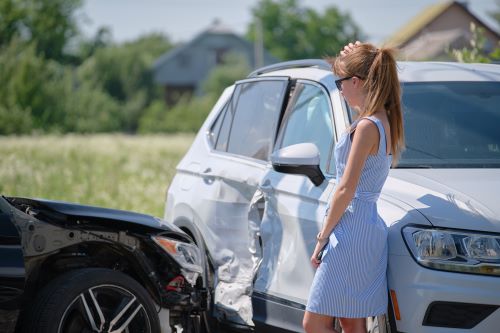Book a Consultation
Find out why so many clients appreciate the amount of work we put into their case.
"*" indicates required fields
Call 24/7

Being involved in a car accident is stressful enough, but dealing with an at-fault driver who is uninsured or underinsured can add an extra layer of complexity. Without sufficient insurance coverage from the responsible party, you might face significant out-of-pocket expenses for damages and injuries.
It’s crucial to know how to navigate these situations to protect your financial interests and ensure that you’re not left bearing the full cost of the accident. Understanding your insurance policy, knowing the steps to take immediately after the accident, and exploring legal options are key aspects of managing this challenging scenario.
Auto insurance policies generally cover liability, collision, comprehensive, and medical expenses. Liability insurance is meant to cover damages you cause to others in an accident.
However, when the at-fault driver is uninsured or underinsured, their liability coverage either doesn’t exist or is insufficient to cover the full extent of the damages. This is where your own coverage becomes critical.
Uninsured Motorist (UM) and Underinsured Motorist (UIM) coverage are optional add-ons to your insurance policy in many states. These types of coverage protect you when you’re involved in an accident caused by a driver who either has no insurance or whose coverage limits are too low to cover the damages.
With UM/UIM coverage, your insurance steps in to cover medical bills, lost wages, and other damages that would have otherwise been covered by the at-fault driver.
The first priority after any accident is ensuring the safety and health of everyone involved. Check yourself and others for injuries, and seek medical attention immediately if needed.
Even if injuries seem minor, it’s wise to have a medical evaluation since some issues, like concussions or internal injuries, may not be immediately apparent.
If you’re physically able, document the accident scene thoroughly. Take pictures of the vehicles, any property damage, road conditions, and injuries.
Here are some relevant forms of evidence you can collect at the scene of an accident:
In addition to all of this, remember to make detailed notes about what happened while the incident is fresh in your mind. This documentation can be crucial for your insurance claim and any potential legal action.
Regardless of the at-fault driver’s insurance status, you should request a police report. A police report provides an official account of the accident, documenting details such as the time, location, involved parties, and a preliminary assessment of fault.
In Utah, if the accident results in over $2,500 in property damage, drivers involved will have to file one as well.
After filing, request a copy of the police report or the report number. This document will be needed for your insurance claim and any legal processes.
Follow up with the police department if you have not received it within a reasonable timeframe.
Once you receive the police report, review it carefully for accuracy. If you notice any errors or omissions, contact the police department to request corrections.
When you find yourself dealing with an at-fault driver who has no insurance, prompt communication with your insurance company is essential. Provide them with all the relevant details and documentation you’ve gathered.
Your insurance company will then investigate the claim, and your UM/UIM coverage will come into play if the other driver is uninsured or underinsured. It’s also important to understand your policy’s coverage limits for both bodily injury and property damage to avoid surprises during the claims process.
Be prepared for negotiations with your insurance adjuster to ensure that the compensation offered adequately covers your damages.
Inform your insurance company of the accident as soon as possible. Provide them with all the details you gathered, including photos, witness information, and the police report.
Your insurance company will investigate the claim, and your UM/UIM coverage will come into play if the at-fault driver is uninsured or underinsured.
Carefully review your insurance policy to understand the coverage limits and what expenses will be covered under your UM/UIM provisions. You may have separate limits for bodily injury and property damage.
It’s crucial to understand these distinctions to avoid surprises during the claims process.
Once you’ve reported the accident, an insurance adjuster will be assigned to your case. The adjuster’s role is to evaluate the extent of damages and determine the compensation you’re entitled to under your policy.
Keep detailed records of all communications with your insurance company, and be prepared to negotiate if the initial offer doesn’t fully cover your damages.
In situations where the at-fault driver has no insurance or is uncooperative, exploring legal options may be necessary. Consulting with an attorney who specializes in UM/UIM claims can help you navigate the complex insurance process and advocate for fair compensation.
If required, you may need to consider suing the at-fault driver, especially if they have assets that could cover your damages. However, weigh the potential costs and recovery carefully, as an uninsured driver may not have substantial financial resources, making it challenging to secure damages through a lawsuit.
When facing a situation involving an uninsured or uncooperative driver, seeking legal guidance is crucial. An attorney specializing in Uninsured Motorist (UM) or Underinsured Motorist (UIM) claims will have the expertise to handle the nuances of these cases.
They can help you understand your rights and options, including:
If the at-fault driver is uninsured and you cannot recover sufficient compensation through your own insurance, suing them may be a viable option. However, before proceeding, consider the following:
If you’ve been involved in an accident with an uninsured or underinsured driver, Valley Law Accident and Injury Lawyers are here to help. Our experienced car accident lawyers understand the complexities of UM/UIM claims and will work tirelessly to ensure you receive the compensation you deserve.
Contact us today at (801) 810-9999 to schedule a consultation, and let us guide you through the recovery process from your accident.
Get in touch


2021 and 2022 Gold Winner for Top Law Firm by Salt City Best
Call 24/7 801-810-9999